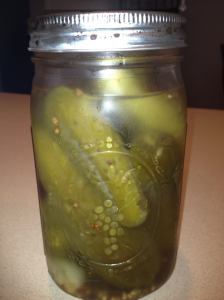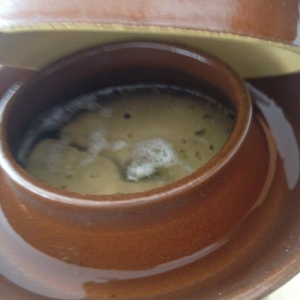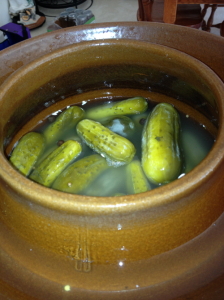
Home-Made pickles are the best
One of my favorite summer memories growing up was going into the refrigerator outside in the cabana space by the pool and grabbing one of the pickles my grandmother made. They were in huge gallon jugs and they were just amazing. After she died, no pickle could compare.
My grandmother was of the old school, meaning she kept her recipes well-guarded. Why I don’t know. But after she died (30 years ago), my life was bereft of pickles. The closest to her recipe was Claussen‘s. But they were still just a whiff of the goodness that was her recipe.
Last year, I set out to make my own. Over the time I’ve been canning, I’ve come to realize that I’m just not a fan of vinegar pickles. For some items the vinegar works well, but not for pickles. I turned to lacto-fermentation instead.
Lacto-Fermentated foods have health benefits as well. They help to normalize stomach acidity, aids in the assimilation of iron and activates pancreas secretion which helps those with diabetes. So as I continue working with food preservation, I want to make sure I bring those health benefits to my diet.
Lacto-fermentation basically relies on a salt brine to help ferment the pickles. I used a recipe from the book “Wild Fermentation“.
The recipe calls for oak leaves, grape leaves or sour cherry leaves to keep the pickles crisp without using lime. Since I have oak trees right outside my house, I went and picked a handful of leaves and washed them thoroughly, trimming off the stems. I also had dill heads from my deck garden.
I’m using Penzy’s pickling spice, garlic and kosher salt as well as small pickling cucumbers from my local orchard store. I made sure the cucumbers were free from rot and blemishes and made sure there were no blossoms on the bottom.
I made a brine, which basically means stirring enough salt and water together (in this case 6 Tablespoons kosher salt and 12 cups of water. The salt needs to be suspended in the water, so stirring can take some time.
I have a 7.5 Liter Harsch Gairtopf Fermentation Crock. I love it. I wish I had bought a bigger one, but I guess I’ll just have to buy another one so I can do more fermentation.
Into the clean crock, I placed the oak leaves, garlic, dill and spices and then I started placing the cucumbers in the crock.
After all the cucumbers are in, I poured the brine over them, making sure all the cucumbers were covered in the brine.
The crock comes with two weights which fit inside the crock. So I placed the weights in the crock, covered it and filled the cover reservoir with water which helps to keep the air out. I left it on my counter for a day to make sure that the brine was at the correct level and working (bubbles are key here) and then moved it to my basement for two weeks.

The Brine is working and I can see some bubbles.
The recipe says I can keep it going for a month, but I like a crisper pickle and two weeks works for me.

My pickles are ready
The pickles need to be stored in fresh brine and pickling spices in the jars in the refrigerator. Canning them will destroy the probiotics created in the lacto-fermentation process. I’ll need to make at least 3 batches this year, cause GC won’t stop eating them. I ate the last one from last summer a few weeks ago.
My first bite of the pickle last year made me burst into tears. It was a mouth memory. I had successfully replicated my grandmother’s pickles. But if anyone in my family wants some, you’ll have to come out here to taste them. These won’t ship.
Related articles











Your pickles are SUPER YUM. I’m probably picking nits, but the leaves in your photograph look like Tulip Poplar (Liriodendron tulipifera) not Oak (Quercus spp.)
Wow, you are right. I know there are oaks in that forest. If I use those, my pickles will probably be even crisper.